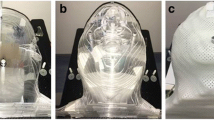Abstract
Purpose
To evaluate radiotherapy treatment planning accuracy by varying computed tomography (CT) slice thickness and tumor size.
Methods
CT datasets from patients with primary brain disease and metastatic brain disease were selected. Tumor volumes ranging from about 2.5 to 100 cc and CT scan at different slice thicknesses (1, 2, 4, 6 and 10 mm) were used to perform treatment planning (1-, 2-, 4-, 6- and 10-CT, respectively). For any slice thickness, a conformity index (CI) referring to 100, 98, 95 and 90 % isodoses and tumor size was computed. All the CI and volumes obtained were compared to evaluate the impact of CT slice thickness on treatment plans.
Results
The smallest volumes reduce significantly if defined on 1-CT with respect to 4- and 6-CT, while the CT slice thickness does not affect target definition for the largest volumes. The mean CI for all the considered isodoses and CT slice thickness shows no statistical differences when 1-CT is compared to 2-CT. Comparing the mean CI of 1- with 4-CT and 1- with 6-CT, statistical differences appear only for the smallest volumes with respect to 100, 98 and 95 % isodoses—the CI for 90 % isodose being not statistically significant for all the considered PTVs.
Conclusions
The accuracy of radiotherapy tumor volume definition depends on CT slice thickness. To achieve a better tumor definition and dose coverage, 1- and 2-CT would be suitable for small targets, while 4- and 6-CT are suitable for the other volumes.




Similar content being viewed by others
References
Dutreix A. When and how we can improve precision in radiotherapy? Radiother Oncol. 1984;2:275–92.
Mah K, Van Dyk J, Keane T, Poon PY. Acute radiation-induced pulmonary damage: a clinical study on the response to fractionated radiotherapy. Int J Radiat Oncol Biol Phys. 1987;13:179–88.
International Commission on Radiation Units and Measurements. Determination of absorbed dose in a patient irradiated by beams of X or Gamma rays in radiotherapy procedures. Bethesda, MD: International Commission on Radiation Units and Measurements. 1976, Report No. 24.
Mijnheer BJ, Batterman JJ, Wambersie A. What degree of accuracy is required and can be achieved in photon and neutron therapy? Radiother Oncol. 1987;8:237–52.
International Commission on Radiation Units and Measurements. Prescribing, Recording and Reporting Photon Beam Therapy. Bethesda, MD: International Commission on Radiation Units and Measurements. 1993, Report No. 50.
International Commission on Radiation Units and Measurements. Prescribing, recording and reporting photon beam therapy (supplement to ICRU report 50). Bethesda, MD: International Commission on Radiation Units and Measurements. 1999, Report No. 62.
Schlegel W, Bortfeld T, editors. A new approach for improved tumor volumetry. Proceedings of the XIIIth International conference on the use of computers in radiation therapy: 2000 May 22–25; Heidelberg, Germany. Berlin: Springer; 2000.
Jansen EP, Dewit LG, van Herk M, Bartelink H. Target volumes in radiotherapy for high-grade malignant glioma of the brain. Radiother Oncol. 2000;56:151–6.
Prabhakar R, Ganesh T, Rath GK, Julka PK, Sridhar PS, Joshi RC, et al. Impact of different ct slice thickness on clinical target volume for 3d conformal radiation therapy. Med Dosim. 2009;34:36–41.
Prionas ND, Ray S, Boone JM. Volume assessment accuracy in computed tomography: a phantom study. J Appl Clin Med Phys. 2010;11(2):3037.
Three-dimensional photon treatment planning. Report of the Collaborative Working Group on the evaluation of treatment planning for external photon beam radiotherapy. Int J Radiat Oncol Biol Phys. 1991;21:1–265.
Brady LW, Heilmann HP, Molls M, Nieder C. Radiation oncology an evidence based approach. Springer. 2008;44:615–6.
Feuvret L, Noël G, Mazeron JJ, Bey P. Conformity index: a review. Int J Radiat Oncol Biol Phys. 2006;64(2):333–42.
Hounsell AR, Wilkinson JM, Williams PC, editors. Quantitative evaluation of treatment planning for linac multi-isocentric radiosurgery.In: Proceedings of the XIth International conference on the use of computers in radiation therapy: 1994 March 20–24; Manchester: Medical Physics Pub; 1994.
Schlegel W, Bortfeld T, editors. Determination of dose–volumes parameters to characterise the conformity of stereotactic treatment plans. In: Proceedings of the XIIIth International conference on the use of computers in radiation therapy: 2000 May 22–25; Heidelberg : Springer; 2000.
Pearson ES, Hartley HO. Charts for the power function for analysis of variance tests, derived from the non central F distribution. Biometria. 1951;38:112–30.
Pedicini P, Caivano R, Fiorentino A, Strigari L, Califano G, Barbieri V, et al. Comparative dosimetric and radiobiological assessment among a nonstandard RapidArc, standard RapidArc, classical intensity-modulated radiotherapy, and 3D brachytherapy for the treatment of the vaginal vault in patients affected by gynecologic cancer. Med Dosim. 2012;37(4):347–52.
Pedicini P, Strigari L, Caivano R, Fiorentino A, Califano G, Nappi A, et al. Local tumor control probability to evaluate an applicator-guided volumetric-modulated arc therapy solution as alternative of 3D brachytherapy for the treatment of the vaginal vault in patients affected by gynecological cancer. J Appl Clin Med Phys. 2013;14(2):4075.
Somigliana A, Zonca G, Loi G, Sichirollo AE. How thick should CT/MR slices be to plan conformal radiotherapy? A study on the accuracy of three-dimensional volume reconstruction. Tumori. 1996;82:470–2.
Plewes DB, Dean PB. The influence of partial volume averaging on sphere detectability in computed tomography. Phys Med Biol. 1981;26:913–9.
Berthelet E, Liu M, Truong P, Czaykowski P, Kalach N, Yu C, et al. CT slice index and thickness: impact on organ contouring in radiation treatment planning for prostate cancer. J Appl Clin Med Phys. 2003;4:365–73.
Fiorentino A, Caivano R, Pedicini P, Fusco V. Clinical target volume definition for glioblastoma radiotherapy planning: magnetic resonance imaging and computed tomography. Clin Transl Oncol. 2013;15(9):754–8.
Conflict of interest
None.
Author information
Authors and Affiliations
Corresponding author
Rights and permissions
About this article
Cite this article
Caivano, R., Fiorentino, A., Pedicini, P. et al. The impact of computed tomography slice thickness on the assessment of stereotactic, 3D conformal and intensity-modulated radiotherapy of brain tumors. Clin Transl Oncol 16, 503–508 (2014). https://doi.org/10.1007/s12094-013-1111-4
Received:
Accepted:
Published:
Issue Date:
DOI: https://doi.org/10.1007/s12094-013-1111-4




